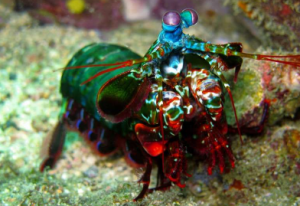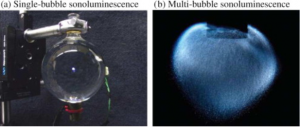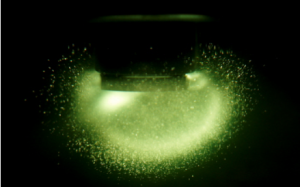Any Bright Ideas About Sonoluminesence?
Written by: Gautham Anne
The mantis shrimp is a crustacean that is well known for its unique hunting ability. They snap their claws 50 mph, with roughly the same acceleration of a 22-caliber bullet, causing water to travel at such high speeds that it “cavitates”. Cavitation occurs when liquids under negative pressure are pulled apart into bubbles of vapor. Over a very short time period, on the order of 100 picoseconds, the bubbles collapse and give off a loud snapping sound. Physicists are interested in studying other consequences of liquid cavitation – the production of small flashes of extremely bright light. They have yet to learn about why these flashes are generated.
Figure 1

Source: FactAnimal.com
What is liquid cavitation?
Liquid cavitation was first observed in 1934 by H. Frenzel and H. Schultes at the University of Cologne as an indirect result of wartime research on sonar radar. When water was subject to strong ultrasonic fields, it cavitated and produced clouds of flashing bubbles, now known as “multi-bubble sonoluminescence.”
Figure 2

Source: Science Direct
Scientists realized that this phenomenon can be reproduced in a laboratory with a fairly simple setup. The collapsing bubbles can be created using sound waves, which are essentially molecules pushing and pulling apart from each other. If the intensity of these waves reaches a certain threshold, the low pressure would be enough for the liquid to pull itself apart into vapor and cause cavitation bubbles. Under specific conditions, the collapsing of the bubbles produces light even brighter than that produced by the mantis shrimps’ strikes. Surprisingly, these light flashes are extremely high-energy. The collapsing bubbles may heat up to 50,000 Kelvin – 10 times hotter than the surface temperature of the Sun! However, scientists have still yet to determine the cause behind these flashes of light.
Figure 3

Collapsing Bubble
Source: Nature
Current Theories
There are numerous theories that attempt to explain the mechanism of sonoluminescence. Many of these can be categorized under either electrical or thermal processes.
The electrical processes describe the charge separation of the bubbles. That is, the bubbles are analogous to spherical capacitors, with charges at the center and along the bubble wall. Phenomena outside the scope of this article cause electric breakdown during the collapse phase. However, these theories assume that the bubbles collapse asymmetrically since symmetric charge distributions do not radiate light.
Theories concerning themselves with the thermal energy of the bubble revolve around adiabatic bubble collapse. Adiabatic systems are those that do not gain or lose thermal energy during a process. This does not mean that the temperature of the bubbles remains constant, but rather that thermal energy is neither added nor subtracted from the bubble throughout its collapse. Specific details are beyond the scope of this article.
In opposition to the thermodynamics theory, a quantum mechanical theory proposed by Julian Schwinger received much popular attention. Similar to the production of Hawking Radiation from black holes, this theory suggests that the process in which the light is emitted is a result of the Casimir Effect. Essentially, the theory states that in a vacuum –similar to that of a negatively pressurized bubble – there exist virtual particles. The rapidly moving juncture between the water and the gas turns virtual photons to real ones. However, a shortcoming to this theory is that critics argue that sonoluminescence releases too much energy in a short timeframe to be accurately described by the vacuum energy explanation.
The production of great amounts of heat and light in sonoluminescence tends to lead the discussion to a particular topic of interest to scientists: nuclear fusion. During the collapse of the bubble, the vapor inside heats up rapidly and produces a flash of light. Naturally, one would suspect that nuclear fusion might have been induced. However, this idea was quickly dispelled. Work by Yuri Didenko and Kenneth Suslick at the University of Illinois showed that endothermic reactions (absorption of heat) during the cavitation process would prevent the temperatures inside the bubble to reach the necessary amount for nuclear fusion.
An Obstacle with Models
A major obstacle preventing breakthroughs in research behind the sonoluminescence mechanism is the method of measuring the interior of bubbles. Currently, the most crucial measurements, like temperature and pressure, are indirectly measured through models of bubble dynamics mainly due to the short lifespan of the bubbles. Bubble dynamics models were made using 5 major assumptions: bubbles remained spherical, the contents of bubbles obey the ideal gas law, the internal pressure of bubbles remained uniform, and evaporation and condensation were not present within the bubble. The fifth assumption pertains to the thermodynamic properties of the bubbles.
Conclusion
Cavitation is a process that is still barely understood, even given the tools of the modern age. This is due to the lack of experimental evidence that can back up certain theories since it is difficult to take measurements of the heat and intensity of light produced from the collapsing bubbles. Resorting to models is currently researchers’ only methodology for observing how sonoluminescence occurs. However, we are in an era where one can buy a sonoluminescence kit online for low prices (www.sonoluminescence.com). Or, we could also adopt a pet mantis shrimp. Either way, the simple setup of the phenomenon is quite unlike the complex concepts that understanding sonoluminescence requires.
References and Sources
American, S. (1999). The bubbles produced by ultrasound in water (sonoluminescence) reach extremely high temperatures and pressures for brief periods. Could these conditions initiate or facilitate nuclear fusion, as suggested in the recent movie "Chain Reaction"?. Retrieved 4 May 2022, from https://www.scientificamerican.com/article/the-bubbles-produced-by-u/
Peplow, M. (2005). Collapsing bubbles have hot plasma core. Nature. doi: 10.1038/news050228-7
Rooze, Joost, Evgeny V. Rebrov, Jaap C. Schouten, and Jos T.F. Keurentjes. 2013. “Dissolved Gas And Ultrasonic Cavitation – A Review”. Ultrasonics Sonochemistry 20 (1): 1-11. doi:10.1016/j.ultsonch.2012.04.013.
Sound Into Light | UCLA Putterman Research Group. (2022). Retrieved 4 May 2022, from http://acoustics-research.physics.ucla.edu/sonoluminescence/
1 thoughts on “Any Bright Ideas About Sonoluminesence?”